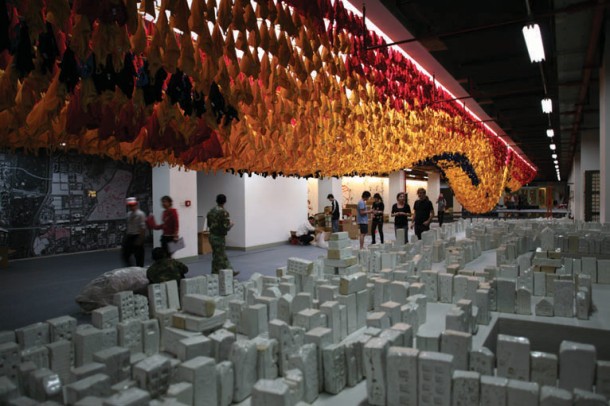SHENZHEN & HONG KONG BI-CITY BIENNALE OF URBANISM/ARCHITECTURE
| February 1, 2010 | Post In LEAP 1

Since 2007, the Shenzhen Biennial or the “Shenzhen Biennale of Urbanism and Architecture” has expanded to Hong Kong to become the “Shenzhen & Hong Kong Bi-City Biennale of UrbanismÄArchitecture.” The 2005 inaugural show’s theme, “Open City, Open Door!” allowed architects to spearhead a vast, public and citywide exhibition. In the 2007 biennial curated by Ma Qingyun, architects focused on “group research” within the theme “City of Expiration and Regeneration” to provide a set of architectural solutions to the problems posed by Shenzhen’s simultaneous rise and decline.
The 2009 biennial still treated the city as prologue, placing architecture in Shenzhen’s central forum (the appropriately named “Citizen Square”) to consider its social import. In this biennial, the hardly new concepts of “public feedback,” “civic awareness” and this year’s clunky theme, “city mobilization,” situated architecture within the city and in full public view. As a result, the architects’ work left academic interrogations hidden inside exhibition halls. Instead, using the communal nature of the site, the architects attempted to transform architecture into a social energy capable of galvanizing the city’s public space. The exhibition clearly showcased the architects’ commitment to society and the openness of the city.
The architects of one type of piece in the biennial exhibited little interest in treating constructed works as vehicles for public dialogue, instead utilizing conceptual substance as the basis for a new, unfinished city. Koolhaas once expressed in an interview that planned and un-built projects can introduce new ways of thinking to the field. Be that as it may, much of the architects’ reasoning at this biennial represented a return to the age of Le Corbusier’s The Radiant City . Whether a substantial concept like Urbanus’ twenty-kilometer university or conceptual substance such as Du Juan and Hong Kong University’s urban ecologies research and design course, discussion of medium’s importance in the city’s public nature were largely abandoned. The architects seemed more interested in addressing ideological demands to treat architectural concepts as an experimental investigation: for example, the need for more citizen architects to produce all kinds of schemes for citizen architecture and then search for opportunities to realize their plans (though this can only ever be partial). Such a direct approach cast aside discussion of the relationship between medium and site, which not only rendered these activities difficult for the public to understand, but also placed architecture in danger of turning against its principles.
The other type of work on display was more inclined toward the temporal union of architectural space and movement on-site, presenting an interactive setting designed to draw social energy from architecture; reports such as Southern Metropolis Daily’s “Climb into a bird’s nest? Nest inside an egg? The Biennial invites you to play with architecture” have surfaced in the news media ad nauseam. Although the architects profess the scholarly nature of their works in the exhibition pamphlet, when they had to endow them with the mantle of “mobilization,” the empty government square in Shenzhen completely stripped these works of their appropriate site-specific significance. As a result, direct connections in the public view between academia and the site could not occur; an architectural opportunity was missed and the momentum for urban revitalization was tragically lost. Compared to works such as DRDH architects’ Model Cities , which might have actually mobilized public participation toward the popularization of architecture off-site, many of the pieces merely functioned as a chance for visitors to fool around without any clear direction. Having brought this predicament on itself, architecture can only bear it silently.
If “Open City, Open Door!” represented the beginnings of an attempt to popularize architecture among the public, and “Expiration and Regeneration” a chance for architects to exercise their rights of discourse, then the present “City Mobilization” revealed that when architecture actually meets the public, it faces the awkwardness of having little to say. Ben Dang Wu Ren

